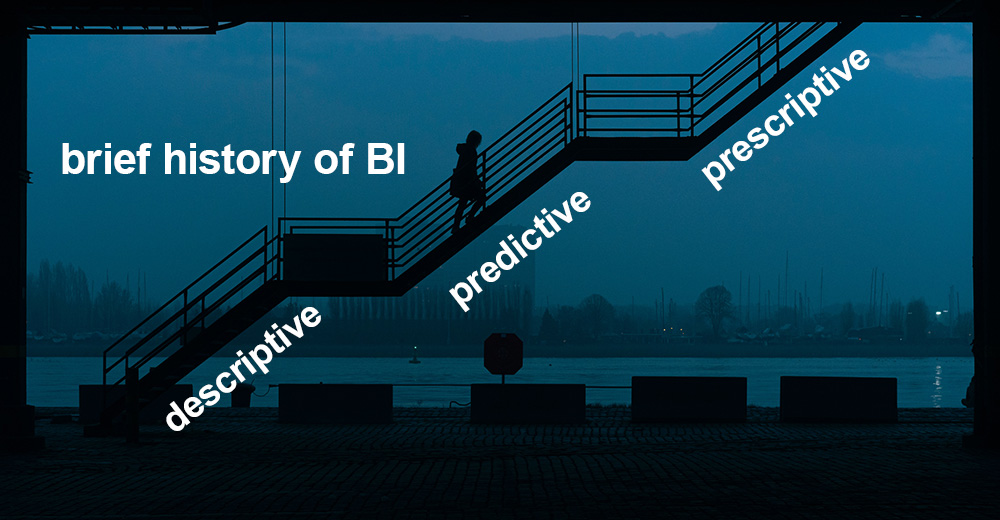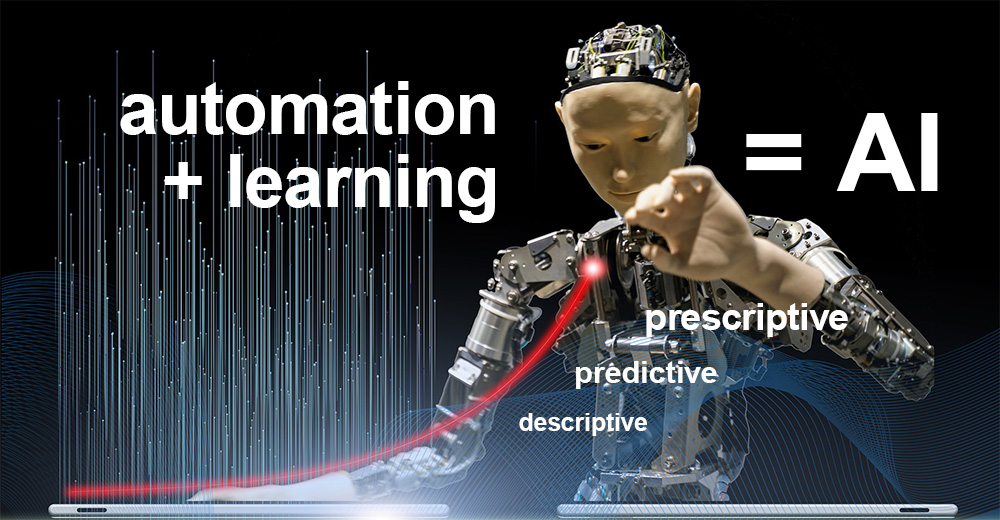AI is the New BI
Artificial intelligence (AI) is a theme that’s been frequently dramatized by the entertainment industry. We see it in the form of humanoid figures with superhuman intelligence. These AI marvels work 24/7, nearly at the speed of light, yet they never get tired or complain. Moreover, they can remember every detail and learn from every experience, so they constantly get smarter.
This understanding of AI won’t actually help businesses leverage its full potential but it’s certainly effective in creating the fear that AI is about to replace us in the job market. Let’s tackle those fears and myths by understanding more realistically what AI can and cannot do to enable business applications.
A Brief History of Business Intelligence
To understand AI in ways that drive business, we must start with something that business is familiar with — business intelligence (BI). BI provides data and analytics to help business leaders make more informed decisions. Over the years, BI has evolved to include three basic types of analytics.
1. Descriptive Analytics
The simplest BI systems are basically reporting engines for descriptive analytics. Descriptive analytics summarizes business operations data and tells you what took place. There are hundreds, maybe thousands, of descriptive analytics, from website page views and social media mentions to percentage calculations such as advertising’s share-of-market or a call center’s average response time.
2. Predictive Analytics
As data volume grows, BI systems also start to incorporate simple predictive analytics. Simply defined, predictive analytics use your existing data to infer data that you don’t, or can’t, have. The most common use case of predictive analytics is to forecast the future trajectory of your data, though it’s important to realize that forecasting is not the only use case.
The most powerful predictive analytics can also be used for data analyses that are not time-dependent. For example, sentiment analysis is a kind of predictive analytics that analyzes text data, such as social media conversations, and infers how consumers feel about a product or a brand.
3. Prescriptive Analytics
As BI systems mature and become even more sophisticated, they may also include prescriptive analytics, which prescribes sets or sequences of actions based on optimizing some objectives. Anyone who has ever shopped at Amazon or watched Netflix knows prescriptive analytics. These platforms recommend products or movies by optimizing the similarity to our preferences.
Another common prescriptive analytics tool many of us use daily is a GPS navigation system, which prescribes routes to take us to our various destinations. This prescriptive analytics optimizes an objective that measures the distance from your starting point to your destination, and prescribes the optimal route that has the shortest distance.
Prescriptive analytics in advanced BI can recommend actions to optimize business processes, marketing effectiveness, ad targeting, and many other business operations.
From Prescription to Automation
BI systems have evolved substantially over the past decades with the addition of predictive and prescriptive analytics to purely descriptive reporting engines. However, BI remains a passive decision-support tool in business. Regardless of what the analytics might suggest, it is the human decision-makers who invariably make the final decisions on what to do.
This is often a good idea because traditional analytics are no match for human intelligence. Expert decisions can often contradict results suggested by analytics. Traditional business analytics is not accurate enough because of the tradeoffs among three types of constraints imposed by the data, the models, and the sheer amounts of computing power.
1. Automation is the Essence of AI
Today’s big data and parallel computing infrastructures which use graphics processing units (GPUs) have alleviated most of those data and computing constraints. This has unleashed the creativity of data scientists and provided them with the freedom to use much more sophisticated models. Some of these models are designed to mimic the processing within the human brain, such as deep neural networks that contain many hidden layers of neurons, and recurrent neural networks that mimic the effects of memory.
Consequently, machine learning (ML) can now train models to produce results that closely match those from human experts. Moreover, by leveraging training data from multiple human experts, today’s ML models can even produce results that outperform any single individual. This can make human decision-making seem redundant. So it’s only a matter of time until we endow machines with the power to make those decisions automatically and cut us humans out of the loop. This automation of decisions and the proper execution of all subsequent actions is the essential step stone to AI.
2. Learning from Feedback Makes AI Smarter
However, if AI is simply the automation of optimal decisions, we can get those same results from simply by automating our familiar prescriptive analytics’ optimized recommendation. So the question becomes, aside from ensuring the results of prescriptive analytics are good enough — defined as comparable to human experts — what makes a system like this truly intelligent?
In fact, decision automation is only the first step in AI. The ability to properly execute all the subsequent actions in a constantly changing world is what makes AI intelligent. This requires AI to leverage the real-time feedback loops that enable AI to learn from every experience and get smarter with every decision it makes.
Real-time feedback already exists in most prescriptive systems because it is closely related to the objectives that are being optimized in all prescriptive analytics. AI uses this constant stream of feedback data to feed its ML engine. This ML will update and improve our prescriptive analytics so the next prescribed decision is optimized even further to bring it closer to (or possibly even better than) what human experts would do.
3. Ability to Adapt to Changes = Intelligence
We already learned that a GPS is an example of prescriptive analytics because it prescribes an optimal route to our destination, based on the optimization of certain objectives, such as distance, travel time, or the least tolls, etc. But we humans are still the ultimate decision-makers when it comes to deciding whether we want to follow the GPS’s recommendations or not.
In the near future, however, AI-powered autonomous vehicles will automate those decisions and execute a sequence of actions to take us directly to our destination. What makes a self-driving car intelligent is the fact that it will take us to our destination safely, regardless of traffic, weather, or other unforeseen road conditions. This ability to decide and follow through with all the subsequent actions in a highly dynamic environment is what makes the AI in autonomous vehicles intelligent. And this is enabled by ML which learns from the environmental feedbacks.
Note that this form of intelligence is not artificial general intelligence (AGI). It is still limited to a very narrow and specific task (i.e. driving), so it’s sometimes referred to as weak AI or artificial narrow intelligence (ANI).
Conclusion
As you can see, AI is merely the automation of an optimal sequence of decisions from prescriptive analytics. And the intelligence of AI comes from the fact that it can leverage real-time feedback data to improve the models in prescriptive analytics so the next prescribed decision will always be better than the previous. This capacity to learn and adapt is what enables AI to faithfully execute the actions which follow from automated decisions in a world full of uncertainties.
As companies become more data savvy, this deeper analytical understanding of AI will facilitate the development of more useful business applications and drive greater profitability. How can you put this understanding of AI into action? Think about your business processes, the decisions and actions you want to automate and what feedback data you need to provide to help your AI learn and become smarter.
DISCLAIMER: The content of this article was first published by CMS Wire. Here is a current revision of the raw manuscript submitted to the publisher, which differs from the previously published version.




